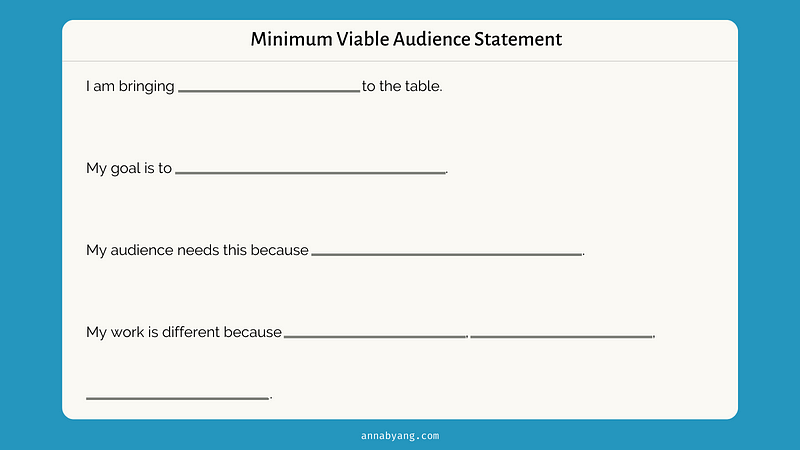What Is a Minimum Viable Audience? (And Why Should You Care?)
Test out your content and unique POV with a small but mighty following.

The creator/solopreneur world sometimes feels crowded. There are a lot of “thought leaders” telling you how to grow your audience and make money online. And usually, they’ve already amassed tens of thousands of followers. At that point, the money is pouring in from various revenue streams.
It’s interesting to reflect from a high perch. But what about people who are in the weeds, trying to figure out what works?
I was a product manager at a fintech before I pivoted into a creative life. I often apply principles of product management to the work I do now. And a key concept for introducing a new product — one that I think applies to creators and solopreneurs just starting out — is finding your minimum viable audience.
In software, a minimum viable product is a product with just enough features to validate an idea. It’s given to a small group of users for feedback so that the development team can iterate and improve.
Unfortunately, many creators chase growing audience size rather than building loyalty. Instead, you should take a product approach and start with a small group that can confirm the value of your work. Success with a minimum might only be a few followers or a small number of sales. But it tells you that you’re on the right track.
Define your core value as a creator
Too often, creators adopt a scarcity mindset. They look at the total audience as a pie with a finite number of slices. If the large solopreneurs take too much of the pie, there won’t be much left for everyone else.
But the reality is that there are billions of people on the internet… and they don’t all like the same type of pie.
Yes, individual people still have limits. They will only spend a part of their day consuming content or a portion of their money on products. But they will shift their attention from one source to another if it better matches their needs. Or maybe your audience isn’t having their needs met at all because no one directly offers what you offer.
Bring a new pie to the table.
To understand how you’re different, look at other creators you admire. Don’t limit yourself to those with a huge following: find someone with mid-sized audiences and review their content journey.
Ask yourself what sets you apart:
- Do you have a unique point of view?
- Do you create with a different style or tone?
- What is your CTA versus other creators? Are you offering consulting services, an eBook, or a newsletter?
Answering these questions will help you target your minimum viable audience.

Presumably, you’re doing work that you love. After all, that’s what drives many people to turn a hobby into a side hustle or a full-blown solopreneur path.
But reaching an audience is different. You’re learning to tweak your passion so that it resonates with an audience. And your experience and your voice will be what sets you apart.
Understand your minimum viable audience
Now that you know the value that you bring to your minimum viable audience, go get them!
Just kidding. It’s not that easy.
Your minimum viable audience should represent:
- A small group of people
- Interested in what you offer
- That you can reach in a cost- and time-effective way
- And who can provide feedback
This audience can exist in so many different places on the internet. Knowing what that audience is and drawing them in are two different things. Especially because every platform is unique in how creators interact with their audience.
Measure your minimum viable audience
Your minimum viable audience may be spread over multiple platforms. Maybe some sign up for your newsletter through an article on Medium. Maybe others arrive via Twitter. The cost- and time-effective part of this exercise is finding the audience without stretching yourself too thin.
A minimum viable audience looks different for every creator, but it should represent something more than vanity metrics. Profile views and impressions aren’t enough because many people click without engaging. Comments, shares, purchases, and subscriptions show you that the audience likes your work enough to interact with it.
Ask yourself:
- How will I measure interactions? (comments, purchases, subscriptions?)
- Over what period of time do I expect to see growth?
- Can I interact with this audience directly? (comment back, send emails, ask for reviews?)
There is a big caveat for solopreneurs that are dependent on their work for income. Your minimum viable audience needs to provide enough revenue to sustain your work. You need to ask, “How much do I need to earn to keep going?” You may not earn it right away — but build out the growth trajectory you need.
Interacting with your audience will be critical. For example, if you have an email list, encourage your audience to reply directly to you. Ask them to share any ideas for topics. If you provide a service, ask your clients to fill out a brief survey when they’re done, giving you feedback on the value provided.
Not only will your audience feel more connected with you, but you can use feedback to iterate and offer new products or pursue new channels.
Don’t waste your time
The worst thing you can do when you’re trying to identify your minimum viable audience is run toward the wrong audience.
Maybe this audience interacts with you… but never converts to a paying customer. Or never shares your work with others to help you grow.
These people are part of your audience, sure. But not part of a viable audience that can sustain your business as a creator.
You’ll want to start testing the engagement with your minimum viable audience. What leads to more interactions and/or more growth?
You don’t need to reinvent the wheel here. Check out what fellow creators have done. After all, successful people have already gone through a “testing” phase. Look back through some of their early iterations — like early posts — and see how they’ve evolved over time.
You can even throw a website in Wayback Machine and see what changes creators have made over the years. Some of the tactics might make sense for you.
Nurture your minimum viable audience
Take some time cultivating the audience on one platform before moving to another. You’ll likely need to engage with your minimum viable audience through several channels. But if you try to do too much in the beginning, you’ll find yourself overwhelmed and burned out.
Once you understand your minimum viable audience in one platform, it’s time to expand. You may not have reached your minimum yet, but you know what it will take to grow.
And remember that audience demands change over time. Just because something works today doesn’t mean it will keep working a year from now. New features may give you new ways to grow your audience. Stay up-to-date on trends within any platform and continue to adjust.
You can read about the future of work and career pivots on my Substack.





